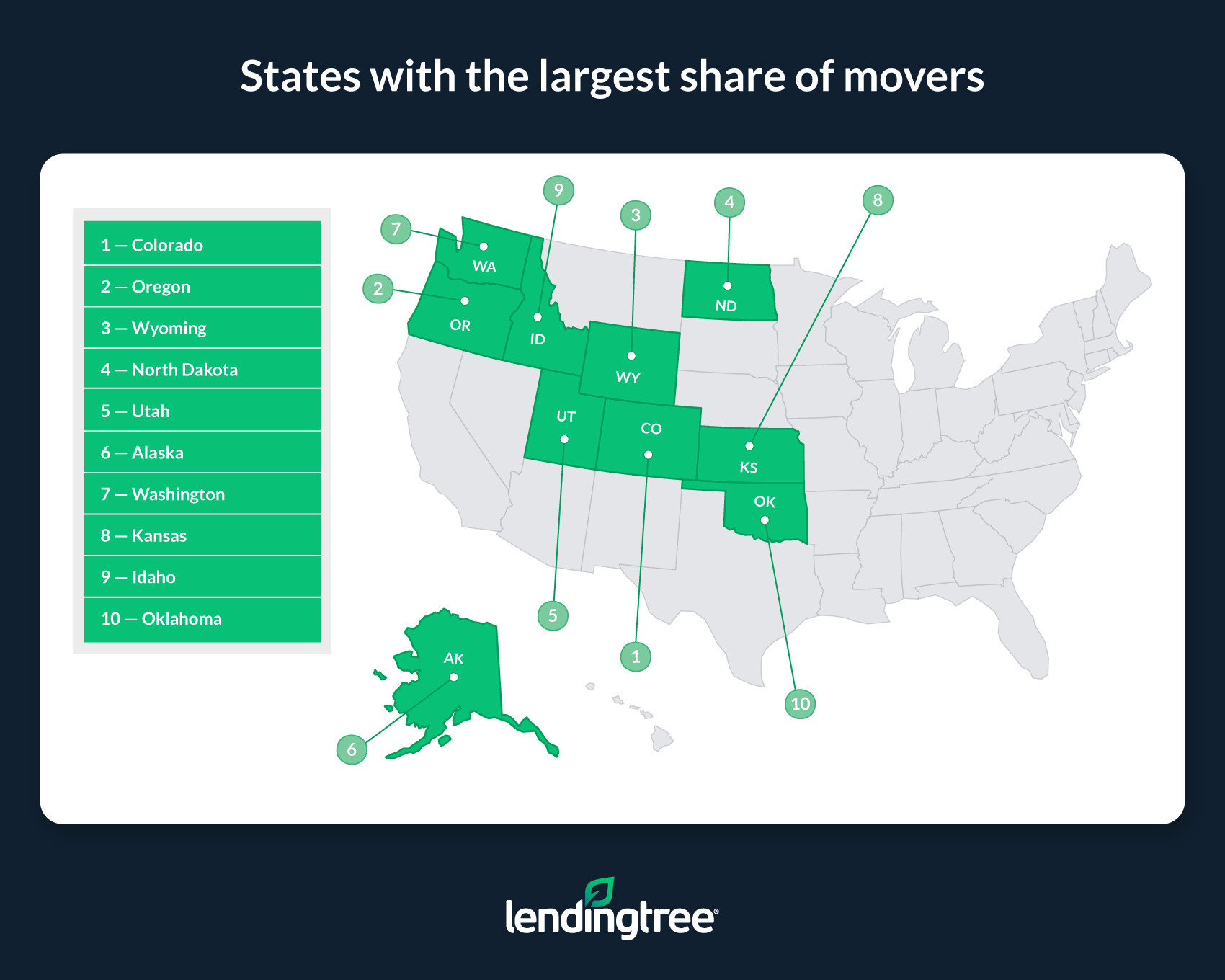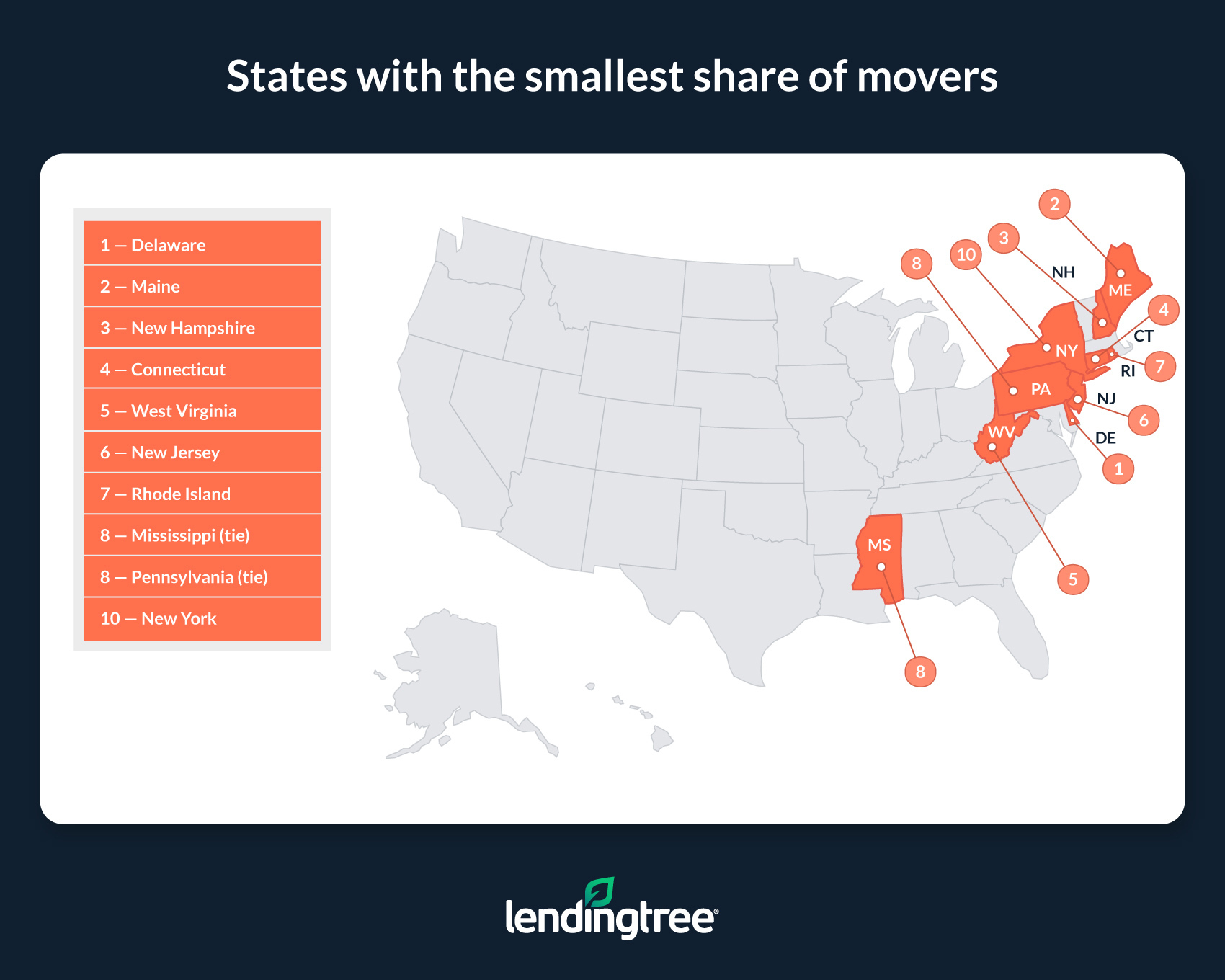Old Familiar Places: American Movers Tend to Stay Near Where They Used to Live
The U.S., at around 3.8 million square miles, offers plenty of places to call home. Many Americans (with exceptions) are free to pack their bags and migrate to another part of the country if they choose.
Despite this ostensible freedom, LendingTree’s latest analysis of U.S. Census Bureau American Community Survey data finds that most Americans aren’t likely to move in a given year.
Across the nation’s 50 states, only 11.21% of Americans moved within a year of the most recent American Community Survey in 2022. Of those who moved, 79.29% stayed in the same state.
Key findings
- Americans are more likely to remain in their homes than pack their bags and move someplace new. 35,753,072 Americans moved to a new home within a year of the 2022 American Community Survey, or 11.21% of the population for whom moving status is tracked. Of that figure, 53.93% moved within their county, 25.36% moved to a different county in the same state and 20.71% moved to a new state.
- Homeowners are less likely to move than renters. 92.67% of Americans in owner-occupied homes stayed in their current residences, versus 80.28% in renter-occupied homes. Homeowners seem more reluctant to move because buying and selling real estate is often more logistically challenging and expensive than renting. They also don’t deal with landlords who could refuse to renew a lease and force them out.
- While homeowners are less likely to move than renters, they tend to go further when they do. 48.91% of American movers who lived in owner-occupied homes left the county or state, compared with 43.75% in renter-occupied homes.
- Movers made up the largest share of the population in Colorado, Oregon and Wyoming. In Colorado, 15.26% of people moved. In Oregon and Wyoming, 14.04% and 13.89% did the same.
- Delaware, Maine and New Hampshire had the smallest share of movers. Respectively, 8.21%, 8.52% and 8.81% of the people who lived in these states moved.
States with the largest share of movers
No. 1: Colorado
- Total population for whom movement status is tracked: 5,634,346
- Share of people who remained in the same home: 84.74%
- Share of people who moved to a new home: 15.26%
- Share of movers who moved in the same county: 42.95%
- Share of movers who moved to a different county in the same state: 31.57%
- Share of movers who moved to a different state: 25.48%
No. 2: Oregon
- Total population for whom movement status is tracked: 4,117,737
- Share of people who remained in the same home: 85.96%
- Share of people who moved to a new home: 14.04%
- Share of movers who moved in the same county: 49.46%
- Share of movers who moved to a different county in the same state: 24.97%
- Share of movers who moved to a different state: 25.57%
No. 3: Wyoming
- Total population for whom movement status is tracked: 559,709
- Share of people who remained in the same home: 86.11%
- Share of people who moved to a new home: 13.89%
- Share of movers who moved in the same county: 53.35%
- Share of movers who moved to a different county in the same state: 15.14%
- Share of movers who moved to a different state: 31.51%

States with the smallest share of movers
No. 1: Delaware
- Total population for whom movement status is tracked: 967,937
- Share of people who remained in the same home: 91.79%
- Share of people who moved to a new home: 8.21%
- Share of movers who moved in the same county: 57.84%
- Share of movers who moved to a different county in the same state: 7.40%
- Share of movers who moved to a different state: 34.76%
No. 2: Maine
- Total population for whom movement status is tracked: 1,321,331
- Share of people who remained in the same home: 91.48%
- Share of people who moved to a new home: 8.52%
- Share of movers who moved in the same county: 50.14%
- Share of movers who moved to a different county in the same state: 24.69%
- Share of movers who moved to a different state: 25.17%
No. 3: New Hampshire
- Total population for whom movement status is tracked: 1,339,570
- Share of people who remained in the same home: 91.19%
- Share of people who moved to a new home: 8.81%
- Share of movers who moved in the same county: 42.59%
- Share of movers who moved to a different county in the same state: 22.07%
- Share of movers who moved to a different state: 35.34%

Why movers generally don’t go far
As our study shows, most movers not only tend to stay in the same state, but they usually stay in the same county. There are various reasons for this.
Outside of upfront costs, staying local has other advantages. For example, despite remote work being a viable option for some, most Americans perform their jobs on-site. This means moving too far from where they live could put a person on the fast track toward unemployment. Even if you’d have no trouble getting a new job after moving to a new county or state, distance from family and friends can also be difficult to overcome.
With all that said, there are certainly plenty of instances where a long-distance move can be more than worth the sacrifices. A completely new area has the potential to provide you access to new opportunities you may not have gotten had you stayed. Going to a new county or state for a higher-paying job or more affordable housing could pay off in the long run.
Long-distance relocations can take a greater toll mentally and financially than staying local. As a result, most Americans don’t appear to be keen on packing their bags and leaving their current stomping grounds. Going forward, this trend will likely persist.
Tips for movers
Whether you’re a homeowner or renter, moving can be a hassle. Here are three tips that can help make it a bit more manageable.
- Shop around for everything from lenders to moving vans. Whether you’re talking about moving companies, landlords or mortgage lenders, different businesses can offer different prices and rates to the same people. Owing to this, shopping around and comparing different offers for everything ranging from a new mortgage to a van to haul your furniture could help you save money during the moving process.
- Get organized. Good organization can make moving less of a chore. Something as simple as creating a checklist where you can keep track of what you’ve packed and whether you’ve notified your bank or insurance company about an address change can help you avoid the stress of accidentally missing something important.
- Know what you’re getting yourself into. In some cases, the grass on the other side of the fence might appear greener than it is. Even if you’re considering moving to a new neighborhood in the same town or city, you’ll want to research and thoroughly vet your new destination before packing. Look into things like noise complaints near the home you’re considering. Also think about commute times, the quality of schools and potential extra costs associated with things like a homeowners association. The more you know, the better you’ll be able to evaluate whether it’s likely to be a good fit for you.
Methodology
Data in this study comes from the U.S. Census Bureau 2022 American Community Survey (ACS) with one-year estimates — the latest survey available at the time of publication. Data was derived from people living in the nation’s 50 states, excluding the District of Columbia.
This study looks at the number of people 1 or older living in a given state one year prior to their household completing the 2022 ACS. It then tracks where those people did or didn’t move to by the time they completed the 2022 ACS.
According to the U.S. Census Bureau: “Residence one year ago is used in conjunction with location of current residence to determine the extent of residential mobility of the population and the resulting redistribution of the population across the various states, metropolitan areas and regions of the country.”
Our study looks at movement trends for the overall population, as well as movement trends for people living in owner-occupied and renter-occupied housing units.
